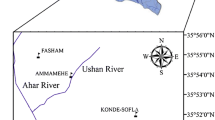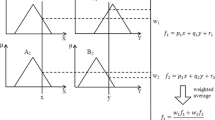Abstract
Sediment transport in streams and rivers takes two forms as suspended load and bed load. Suspended load comprises sand + silt + clay-sized particles that are held in suspension due to the turbulence and will only settle when the stream velocity decreases, such as when the streambed becomes flatter, or the streamflow into a pond or lake. The sources of the suspended sediments are the sediments transported from the river basin by runoff or wind and the eroded sediments of the river bed and banks. Suspended-sediment load is a key indicator for assessing the effect of land use changes, water quality studies and engineering practices in watercourses. Measuring suspended sediment in streams is real sampling and the collection process is both complex and expensive. In recent years, artificial intelligence methods have been used as a predictor for hydrological phenomenon namely to estimate the amount of suspended sediment. In this paper the abilities of Support Vector Machine (SVM), Artificial Neural Networks (ANNs) and Adaptive Network Based Fuzzy Inference System (ANFIS) models among the artificial intelligence methods have been investigated to estimate the suspended sediment load (SSL) in Ispir Bridge gauging station on Coruh River (station number: 2316). Coruh River is located in the northern east part of Turkey and it is one of the world”s the fastest, the deepest and the largest rivers of the Coruh Basin. In this study, in order to estimate the suspended sediment load, different combinations of the streamflow and the SSL were used as the model inputs. Its results accuracy was compared with the results of conventional correlation coefficient analysis between input and output variables and the best combination was identified. Finally, in order to predict SSL, the SVM, ANFIS and various ANNs models were used. The reliability of SVM, ANFIS and ANN models were determined based on performance criteria such as Root Mean Square Error (RMSE), Mean Absolute Error (MAE), Efficiency Coefficient (EC) and Determination Coefficient (R2).





Similar content being viewed by others
References
Afan HA, El-Shafie A, Yaseen ZM, Hameed MM, Wan Mohtar WHM, Hussain A (2015) ANN based sediment prediction model utilizing different input scenarios. Water Resour Manag 29:1231–1245
Alp M, Cigizoglu HK (2007) Suspended sediment load simulation by two artificial neural network methods using hydrometeorological data. Environmental Modeling and Software 22:2–13
Broomhead D, Lowe D (1988) Multivariable functional interpolation and adaptive networks. Complex Systems 2(6):568–576
Caudill M, Butler C (1992) Understanding neural networks: 1 basic networks. The MIT Press, Cambridge
Chong EKP, Zak SH (1996) An introduction to optimization. John Wiley&Sons, Inc
Cigizoglu HK (2003) Estimation, forecasting and extrapolation of river flows by artificial neural networks. Hydrological Sciences 48(3):349–361
Cigizoglu HK, Alp M (2005) Generalized regression neural network in modelling river sediment yield. Adv Eng Softw 37:63–68
Cigizoglu HK, Kisi O (2006) Methods to improve the neural network performance in suspended sediment estimation. J Hydrol 317(3–4):221–238
Dawson CW, Wilby RL (1998) An artificial neural network approach to rainfall –runoff modeling. Hydrol Sci J 43(1):47–66
Dawson CW, Wilby RL (2001) Hydrological modelling using artificial neural networks. Prog Phys Geogr 25:80–108
Demirel O, Kakilli A, Tektaş M (2010) ANFIS ve ARMA modelleri ile Elektrik enerjisi yük tahmini. Gazi Üniv Müh Mim Fak Dergisi 25(3):601–610 (in Turkish)
Dogan E (2009) Katı madde konsantrasyonunun yapay sinir ağlarını kullanarak tahmin edilmesi. İMO Teknik Dergi 302:4567–4582 (in Turkish)
Ebtehaj I, Bonakdari H (2014) Performance evaluation of adaptive neural fuzzy inference system for sediment transport in sewers. Water Resour Manag 28:4765–4779
Ekici S (2007) Elektrik Güç Sistemlerinde Akıllı Sistemler Yardımıyla Arıza Tipi ve Yerinin Belirlenmesi. PhD Thesis. Fırat Üniversitesi. Fen Bilimleri Enstitüsü (in Turkish)
Goyal MK (2014) Modeling of sediment yield prediction using M5 model tree algorithm and wavelet regression. Water Resour Manag 28:1991–2003
Hassan M, Shamim MA, Sikandar A, Mehmood I, Ahmed I, Ashiq S, Khitab A (2015) Development of sediment load estimation models by using artificial neural networking techniques. Environ Monit Assess 187(11):686
Hoya T, Chambers JA (2001) Heuristic pattern correction scheme using adaptively trained generalized regression neural networks. IEEE Trans. on Neural Networks 12(1):91–100
Jang JSR (1993) ANFIS adaptive –network-based-fuzzy inference systems. IEEE trans. On. Systems, Man and Cybernetics 23(3):665–685
Jang JSR, Tsai C, Mizutani E (1997) Neuro- fuzzy and soft computing: a computational approach to learning and machine intelligence. Prentice-Hall, Inc., N.J
Kisi O, Ozkan C, Akay B (2012a) Modeling discharge–sediment relationship using neural networks with artificial bee colony algorithm. J Hydrol 428–429:94–103
Kisi O, Dailr AH, Cimen E, Shiri J (2012b) Suspended sediment modeling using genetic programming and soft computing tecniques. J Hydrol 450-451:48–58
Kumar SA, Ojha C, Goyal M, Singh R, Swamee P (2012) Modeling of suspended sediment concentration at Kasol in India using ANN, fuzzy logic, and decision tree algorithms. J Hydrol Eng 17(3):394–404
Lafdani EK, Nia AM, Ahmadi A (2013) Daily suspended sediment load prediction using artificial neural networks and support vector machines. J Hydrol 478:50–62
Melesse AM, Ahmad S, McClaina ME, Wang X, Limd YH (2011) Suspended sediment load prediction of river systems: an artificial neural network approach. Agric Water Manag 98:855–866
Miller CB (1951) Analysis of flow–duration, sediment- rating curver method of conputing sediment yield. U.S. Department of Interior, Bureau of Reclamation Sedimantation, Denver, Colorado
Moller MF (1993) A scaled conjugate gradient algorithm for fast supervised learning. Neural Netw 6:525–533
Moriasi DN, Arnold JG, Van Liew MW, Bingner RL, Harmel RD, Veith TL (2007) Model evaluation guidelines for systematic quantifi cation of accuracy in watershed simulations. Trans ASABE 50:885–900
Muftuoglu RF (1980) Akarsu Yapıları, Cilt 1. İTÜ İnşaat Fakültesi Matbaası, İstanbul (in Turkish)
Nourani V, Alizadeh F, Roushangar K (2016) Evaluation of a two-stage SVM and spatial statistics methods for modeling monthly river suspended sediment load. Water Resour Manag 30:393–407
Ozturk F, Apaydin H, Walling DE (2001) Suspended sediment loads through flood events for streams of Sakarya Basin, Turkish J Eng Env. TÜBİTAK 25:643–650
Paredes V, Vidal E (2000) A class-dependent weighted dissimilarity measure for nearest neighbor classification problems. Pattern Recogn Lett 21:1027–1036
Park J (2006) Uncertainty and sensitivity analysis in support vector machines: Robuts optimization and uncertain programming approaches, dissertation. Norman, Oklahoma
Partal T, Cigizoglu HK (2008) Estimation and forecasting of daily suspended sediment data using wavelet-neural network. J Hydrol 358:317–331
Salat R, Osowski S (2004) Accurate fault location in the power transmission line using support vector machine approach. Power Systems IEEE Transactions on 19:879–886
Sen Z (2004) Yapay Sinir Ağı İlkeleri. İstanbul, Su Vakfı Yayınları (in Turkish)
Shepherd AJ (1997) Second-order methods for neural networks. Springer Verlag London Ltd.
Singh A, Imtiyaz M, Isaac RK, Denis DM (2013) Comparison of artificial neural network models for sediment yield prediction at single gauging station of watershed in eastern India. J Hydrol Eng 18(1):115–120
Sivakumar B (2006) Suspended sediment load estimation and the problem of inadequate data sampling: a fractal view. Earth Surf Process Landf 31:414–427
Skapura DM (1996) Building neural networks. Addison-Wesley, New York
Specht DF (1991) General regression neural network. IEEE Trans on Neural Networks 2(6):568–576
Vapnik V (1995) The nature of statistical learning theory. Springer, New York
Verleysen M, Hlavackova K (1994) An optimized RBF network for approximation of functions. Proceedings European Symposium on Artificial Neural Networks. Brussels, Belgium, pp 175–180
Yang CT (1996) Sediment transport theory and practice. McGraw-Hill, USA
Yanmaz M, Kumcu SY (2007) Measurement of sediment load. Post-graduate course in sediment transport technology. DSI press, Ankara
Author information
Authors and Affiliations
Corresponding author
Rights and permissions
About this article
Cite this article
Buyukyildiz, M., Kumcu, S.Y. An Estimation of the Suspended Sediment Load Using Adaptive Network Based Fuzzy Inference System, Support Vector Machine and Artificial Neural Network Models. Water Resour Manage 31, 1343–1359 (2017). https://doi.org/10.1007/s11269-017-1581-1
Received:
Accepted:
Published:
Issue Date:
DOI: https://doi.org/10.1007/s11269-017-1581-1




